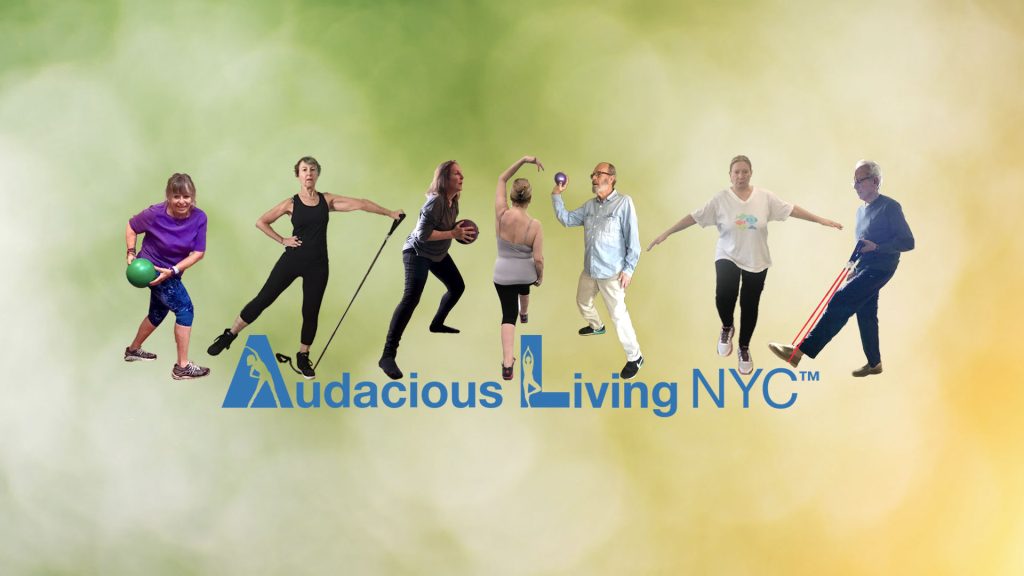The average person starting an exercise program may have knee, or back pain, and goals other than “how do I get a six pack or run a marathon.” All the workouts in the world don’t mean anything if we can’t sit, stand, and get out of bed in ways that don’t strain our body.

For many people, exercise is a way to maintain or improve their quality of life. But what good is walking 10,000 steps a day if you can’t scramble up subway steps with ease, run for a bus without knee pain, or lift a toddler without wrenching your back? That’s the focus of functional fitness. Functional fitness exercises are designed to train and develop your muscles to make it easier and safer to perform everyday activities, such as carrying groceries, or playing a game of basketball with your kids.
Functional Fitness Training: Is it right for you?
Functional fitness exercises train our muscles to help us do everyday activities safely and efficiently. With functional fitness, our work out goal is to prepare our body to perform daily activities — walking, bending, lifting, climbing stairs — without pain, injury, or discomfort. Functional fitness workouts challenge our body to work as a whole, teaching us to use multiple muscle groups in an integrated way.
Because it incorporates multiple muscles, functional fitness exercise is an effective alternative to conventional training for those trying to lose weight. Functional fitness exercises train our muscles to work together and prepare them for daily tasks by simulating everyday activities done at home, at work or in sports. Functional fitness is training for life, not events. By performing exercises that mimic movement that we do out in the “real world,” we target multiple muscle groups and reap full-body benefits in less time.
Our first goal with exercise should be to learn how to control our body. While we may be able to press a lot of weight on a leg-press machine, we may not be able to stand on one leg. That’s why many of us experience pain when we walk down stairs or reach up to get something out of a high cabinet.
Functional exercises use multiple joints and numerous muscles at the same time. Using muscles in our upper and lower body at the same time, functional fitness exercises emphasize endurance, balance, posture, core stability, strength, coordination, and agility.

For example, a squat is a functional exercise because it trains the muscles used when we rise up and down from a chair or pick up objects. By training our muscles to work the way they do in everyday tasks, we prepare our body to perform well in a variety of common situations.
Components of functional fitness
The seven functional movements our body can perform are variations of these:
- Pull
- Push
- Squat
- Lunge
- Hinge
- Rotation
- Gait
The purpose of exercises in each of these movements is to keep muscles functioning as they were designed. Activities such as walking, jogging, running, sprinting, jumping, climbing, lifting, bending, twisting, turning, even standing, are improved by training to improve functional strength.
The Functional Fitness Payoff
Whether our goal is getting stronger, shedding pounds, or becoming a well-rounded athlete, having control of our movement can lead to greater gains. For 90 percent of people, 90 percent of the time, functional, total-body training is the way to go. Rarely do we just bend one joint in one plane of motion to accomplish any task.
Performing workouts that rely on complex, multi-joint movements will engage more muscle groups. Because of that, we will burn more calories and build more muscle.
Functional, full-body workout routines are great for beginners because at the start, just about exertion produces noticeable results. Seeing improvements is a great motivator. Also, the more we like our workouts, the more likely we are to keep showing up. Functional, total-body training also allows us to integrate our training around a busy schedule and pursue other activities, like swimming, biking, or hiking.
Jacqueline Gikow, is the owner of Audacious Living NYC™. Her holistic, health and wellness practice centers on pain relief through better movement. She is certified through the National Association of Sports Medicine (NASM), the National Board of Medical Examiners (NBCHWC), the Functional Aging Institute (FAI), MedFit, and the Arthritis Foundation (AFAP/AFEP). Her fitness practice includes in-home and remote, one-on-one fitness training and coaching in New York City. Jacqueline Gikow can be reached at https://audaciouslivingnyc.com, or on Facebook: https://www.facebook.com/groups/audaciouslivingnyc

